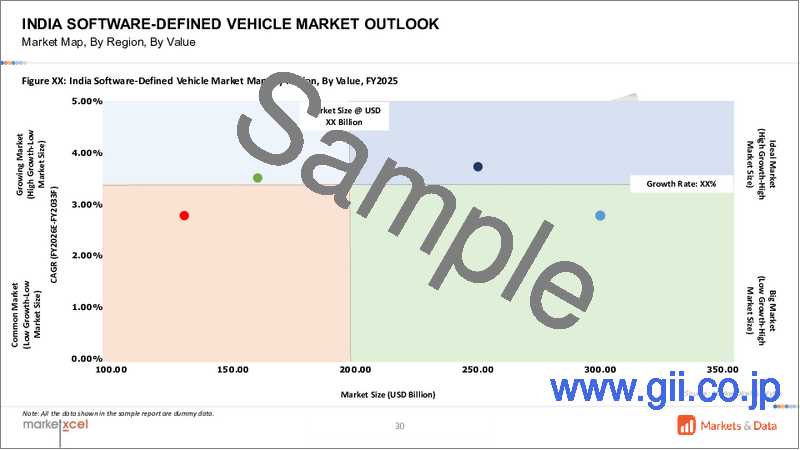|
|
市場調査レポート
商品コード
1745793
SDV(Software Defined Vehicle)のインド市場:車両タイプ別、推進別、車両自律性別、SDVタイプ別、地域別、機会、予測、2019年~2033年India Software-Defined Vehicle Market Assessment, By Vehicle Type, By Propulsion, By Vehicle Autonomy, By Software-Defined Vehicle Type, By Region, Opportunities and Forecast, FY2019-FY2033F |
||||||
カスタマイズ可能
|
|||||||
| SDV(Software Defined Vehicle)のインド市場:車両タイプ別、推進別、車両自律性別、SDVタイプ別、地域別、機会、予測、2019年~2033年 |
|
出版日: 2025年06月11日
発行: Markets & Data
ページ情報: 英文 123 Pages
納期: 3~5営業日
|
全表示
- 概要
- 図表
- 目次
インドのSDV(Software Defined Vehicle)市場は、2026年~2033年の予測期間中にCAGR 16.56%を記録し、2025年の26億9,000万米ドルから2033年には91億6,000万米ドルに成長すると予測されています。同市場は近年著しい成長を遂げており、安全性と持続可能な輸送に対する意識の高まり、自動車の著しい技術進歩、自動車技術の急速な進化により、今後も拡大を維持すると予想されます。インドのSDV市場の需要は、電気自動車やハイブリッド車の生産台数の増加、運転中の快適性や利便性に対する需要の高まり、自動車のOTA(Over-The-Air)システムの統合などにより増加すると予想されます。OTAは、自動車メーカーが遠隔操作で車両ソフトウェアを進化させることを可能にし、ディーラーに出向くことなく性能、機能、ユーザー体験を定期的に向上させることを可能にします。エンドユーザーは、スマートフォンのように、時間の経過とともに自動車が改良されることを期待しています。
さらに、OTAアップデートは、必要不可欠な安全強化やセキュリティパッチを迅速に提供することもできます。自動車はますます接続されるようになり、最新のセキュリティ機能を備えていることが確認され、予測期間におけるインドのSDV市場の需要を促進しています。さらに、インド政府は高度な道路網やスマート交通管理システムなどのインフラへの投資を進めており、インドにおけるSDVの成長を支えています。また、同市場に参入している企業は、ソフトウェアのアップデートによって新機能が追加されるため、時間の経過とともに車両の価値を高めています。市場の主要参入企業は、市場でのプレゼンスを拡大し、SDVの需要増に対応するために協力しています。
例えば、BMW AGは2024年4月、SDV分野の進展を加速させるため、自動車用ソフトウェアとビジネスITソリューションの開発でTata Technologiesと協業することを発表しました。
目次
第1章 プロジェクトの範囲と定義
第2章 調査手法
第3章 米国の関税の影響
第4章 エグゼクティブサマリー
第5章 顧客の声
- ブランド認知度
- 購入決定時に考慮される要素
- コネクテッドカー機能とインフォテインメント
- 費用対効果
- ソリューションの効率
- 無線(OTA)アップデート
- プライバシーと規制の考慮
第6章 インドのSDV市場の展望、2019年~2033年
- 市場規模分析と予測
- 金額別
- 市場シェア分析と予測
- 車両タイプ別
- 乗用車
- 商用車
- 推進別
- ICE車
- EV
- 車両自律性別
- レベル1
- レベル2
- レベル3
- レベル4
- レベル5
- SDVタイプ別
- 半SDV
- SDV
- 地域別
- 北部
- 南部
- 東部
- 西部と中央部
- 企業別の市場シェア分析(上位5社・その他 - 金額ベース、2025年)
- 車両タイプ別
- 2025年の市場マップ分析
- 車両タイプ別
- 推進別
- 車両自律性別
- SDVタイプ別
- 地域別
第7章 バリューチェーン分析
第8章 ポーターのファイブフォース分析
第9章 PESTLE分析
第10章 市場力学
- 市場促進要因
- 市場の課題
第11章 市場動向と発展
第12章 ケーススタディ
第13章 競合情勢
- 市場リーダー上位5社の競合マトリックス
- 上位5社のSWOT分析
- 上位10社の主要企業の情勢
- Aptiv Plc
- Continental AG
- Mobileye Technologies Limited
- Nvidia Corporation
- Robert Bosch GmbH
- Tesla, Inc.
- Waymo LLC
- Qualcomm Incorporated
- ZF Friedrichshafen AG
- Hyundai Mobis
第14章 戦略的提言
第15章 調査会社について・免責事項
List of Tables
- Table 1. Competition Matrix of Top 5 Market Leaders
- Table 2. Mergers & Acquisitions/ Joint Ventures (If Applicable)
- Table 3. About Us - Regions and Countries Where We Have Executed Client Projects
List of Figures
- Figure 1. India Software-Defined Vehicle Market, By Value, In USD Billion, FY2019-FY2033F
- Figure 2. India Software-Defined Vehicle Market Share (%), By Vehicle Type, FY2019-FY2033F
- Figure 3. India Software-Defined Vehicle Market Share (%), By Propulsion, FY2019-FY2033F
- Figure 4. India Software-Defined Vehicle Market Share (%), By Vehicle Autonomy, FY2019-FY2033F
- Figure 5. India Software-Defined Vehicle Market Share (%), By Software-Defined Vehicle Type, FY2019-FY2033F
- Figure 6. India Software-Defined Vehicle Market Share (%), By Region, FY2019-FY2033F
- Figure 7. By Vehicle Type Map-Market Size (USD Billion) & Growth Rate (%), 2024
- Figure 8. By Propulsion Map-Market Size (USD Billion) & Growth Rate (%), 2024
- Figure 9. By Vehicle Autonomy Map-Market Size (USD Billion) & Growth Rate (%), 2024
- Figure 10. By Software-Defined Vehicle Type Map-Market Size (USD Billion) & Growth Rate (%), 2024
- Figure 11. By Region Map-Market Size (USD Billion) & Growth Rate (%), 2024
India software-defined vehicle market is projected to witness a CAGR of 16.56% during the forecast period FY2026-FY2033F, growing from USD 2.69 billion in FY2025 to USD 9.16 billion in FY2033. The market has experienced significant growth in recent years and is expected to maintain an expansion in the coming years owing to enhanced awareness about safety and sustainable transportation, significant technological advancement in vehicles, and the rapidly evolving landscape of automotive technology. The India software-defined vehicle market demand is anticipated to increase owing to the growing production of electric and hybrid vehicles, a rise in demand for comfort and convenience while driving, and an integration of automotive Over-The-Air (OTA) systems. OTA allows automakers to advance vehicle software remotely, enabling regular enhancements in performance, functionality, and user experience without requiring a dealership visit. This capability surges the demand for software-defined vehicles, as end users expect their vehicles to enhance over time, such as smartphones.
In addition, OTA updates also can provide essential safety enhancements and security patches swiftly. As vehicles become increasingly connected, confirming they are featured the latest security features, propelling the India software-defined vehicle market demand in the forecast period. Furthermore, the Indian government is investing in infrastructure including advanced road networks, and smart traffic management systems, supporting the growth of software-defined vehicles in India. Also, companies in the market are increasing the value of the vehicle over time as new features are added via software updates. Key participants in the market are collaborating to expand their market presence and address the rising demand for software-defined vehicles.
For instance, in April 2024, BMW AG announced to collaboration with Tata Technologies for the development of automotive software and business IT solutions to accelerate the progress in the field of software-defined vehicles.
Electrification of Vehicle Drives the India Software-Defined Vehicle Market Growth
The significant shift towards electrification is a key driver in India software-defined vehicle market. The government of India formed different initiatives, including the Faster Adoption and Manufacturing of Hybrid and Electric Vehicles (FAME) scheme, which are motivating automakers to introduce electric vehicles featured with advanced software. This transition not only minimizes emissions but also improves vehicle performance and user experience, driving the India software-defined vehicle market growth. Moreover, the growing awareness among consumers about sustainable options, accelerating the integration of electric vehicle technology into software-defined vehicles is projected to surge, fostering innovation and market growth. In addition, companies in the market are considerably investing in software solutions that manage regenerative braking, battery effectiveness, and advanced charging infrastructure. Furthermore, market participants in the market are efficiently launching different intelligent centers to help manufacture advanced software-defined vehicles.
For instance, in March 2023, BlackBerry Limited announced the launch of an IoT center of excellence in India for embedded software engineers to support building the next generation of software-defined vehicles.
Integration of Advanced Driver Assistance Systems (ADAS) Pushes the India Software-Defined Vehicle Market Demand
The integration of ADAS is gaining prevalence in India software-defined vehicle market owing to rising government regulations on road and vehicle safety and growing consumer awareness. Features including lane-keeping assistance, adaptive cruise control, and automatic emergency braking are becoming a significant market trend. Automakers are integrating advanced software systems to advance these functionalities, improving vehicle safety, the overall driving experience of end users and enhancing user comfort. The demand for vehicles equipped with ADAS is probably to rise because road safety is becoming a priority among consumers. In addition, collaborations between tech companies and automakers are propelling advancements in this domain, leading to fully autonomous driving capabilities, which further propel the India software-defined vehicle market demand in the forecast period.
For instance, in July 2024, Tata Technologies announced the collaboration with Arm Limited to drive innovation in software-defined vehicles and reduce the development time of software-defined vehicles for automotive OEMs.
Passenger Cars Dominate India Software-Defined Vehicle Market Share
Passenger cars dominate the market growth owing to the increasing production of passenger cars in emerging countries, rising disposable incomes, and rapid urbanization. The software-defined passenger car demand in India is projected to accelerate owing to a growing demand for smart and connected features in vehicles, significant technological advancements, and rising awareness and requirement for advanced driver-assistance systems in automobiles. Also, innovations in software and hardware are making it easier for automakers to integrate advanced technologies into passenger cars, making them more appealing to buyers. Additionally, government initiatives focused on promoting electric vehicles and advanced technologies are often aimed at passenger vehicles, motivating manufacturers to invest in software-defined vehicle capabilities, which further drive the software-defined passenger cars in India. Companies in the market are launching passenger cars with the integration of different software and hardware to address the rising demand for advanced and connected passenger cars.
For instance, launched in June 2025, the Tata Harrier EV is a significant example in passenger car segment, showcasing the integration of software-defined vehicle capabilities. It comes equipped with a level-2 ADAS suite that includes features such as adaptive Cruise Control, driver attention warning, auto park assists.
Aftermarket is Expected to Register Significant Market Share in the India Software-Defined Vehicle Market
Aftermarket is projected to hold a significant market share in the Indian market for software-defined vehicles owing to increased demand for vehicle connectivity, rapid trend of personalization, rising requirements for upgrading their existing vehicles, and stringent government rules and regulations. As automakers are introducing more advanced vehicles, owners look for advancements and upgrades rather than new purchases, leading to higher requirements for aftermarket solutions. Constant software updates for road and vehicle safety, navigation, and infotainment systems features will further boost India automotive aftermarket market growth. The significant surge in electric vehicles introduces different market growth opportunities for market players. In addition, the partnership between tech companies and automotive manufacturers will foster innovation in aftermarket services.
For instance, in April 2024, Tata Technologies announced to formation of a joint venture with BMW AG to introduce an automotive software and IT hub in Pune, Bengaluru, and Chennai. The joint venture will focus on strategic software development, including solutions for software-defined vehicles, digital services in the aftermarket, automated driving, and infotainment systems.
Key Players Landscape and Outlook
To enhance their market reach and offerings, Indian software-defined vehicle companies are embracing next-gen technologies like over-the-air (OTA) updates and autonomous driving systems. These software-driven advancements improve vehicle performance, safety, and user experience while enabling faster feature upgrades. By prioritizing a software-first approach, these firms can swiftly adapt to industry changes and roll out innovations. Strategic alliances with global tech leaders and increased R&D investments further help them stay competitive and address shifting consumer needs. As a result, they not only solidify their market standing but also drive greater customer engagement and brand loyalty.
For instance, in October 2024, Hyundai Motor Company, Kia Corporation, and Samsung Electronics announced a partnership to connect software-defined vehicle to smartphones and introduce a new mobility experience for customers.
Table of Contents
1. Project Scope and Definitions
2. Research Methodology
3. Impact of U.S. Tariffs
4. Executive Summary
5. Voice of Customers
- 5.1. Brand Awareness
- 5.2. Factors Considered in Purchase Decisions
- 5.2.1. Connected Car Features and Infotainment
- 5.2.2. Cost-Effectiveness
- 5.2.3. Efficiency of Solutions
- 5.2.4. Over-the-Air (OTA) Updates
- 5.3. Consideration of Privacy and Regulations
6. India Software-Defined Vehicle Market Outlook, FY2019-FY2033F
- 6.1. Market Size Analysis & Forecast
- 6.1.1. By Value
- 6.2. Market Share Analysis & Forecast
- 6.2.1. By Vehicle Type
- 6.2.1.1. Passenger Vehicle
- 6.2.1.2. Commercial Vehicle
- 6.2.2. By Propulsion
- 6.2.2.1. Internal Combustion Engine Vehicle
- 6.2.2.2. Electric Vehicle
- 6.2.3. By Vehicle Autonomy
- 6.2.3.1. Level 1
- 6.2.3.2. Level 2
- 6.2.3.3. Level 3
- 6.2.3.4. Level 4
- 6.2.3.5. Level 5
- 6.2.4. By Software-Defined Vehicle Type
- 6.2.4.1. Semi-Software-Defined Vehicle
- 6.2.4.2. Software-Defined Vehicle
- 6.2.5. By Region
- 6.2.5.1. North
- 6.2.5.2. South
- 6.2.5.3. East
- 6.2.5.4. West and Central
- 6.2.6. By Company Market Share Analysis (Top 5 Companies and Others - By Value, FY2025)
- 6.2.1. By Vehicle Type
- 6.3. Market Map Analysis, FY2025
- 6.3.1. By Vehicle Type
- 6.3.2. By Propulsion
- 6.3.3. By Vehicle Autonomy
- 6.3.4. By Software-Defined Vehicle Type
- 6.3.5. By Region
7. Value Chain Analysis
8. Porter's Five Forces Analysis
9. PESTLE Analysis
10. Market Dynamics
- 10.1. Market Drivers
- 10.2. Market Challenges
11. Market Trends and Developments
12. Case Studies
13. Competitive Landscape
- 13.1. Competition Matrix of Top 5 Market Leaders
- 13.2. SWOT Analysis for Top 5 Players
- 13.3. Key Players Landscape for Top 10 Market Players
- 13.3.1. Aptiv Plc
- 13.3.1.1. Company Details
- 13.3.1.2. Key Management Personnel
- 13.3.1.3. Products and Services
- 13.3.1.4. Financials (As Reported)
- 13.3.1.5. Key Market Focus and Geographical Presence
- 13.3.1.6. Recent Developments/Collaborations/Partnerships/Mergers and Acquisition
- 13.3.2. Continental AG
- 13.3.3. Mobileye Technologies Limited
- 13.3.4. Nvidia Corporation
- 13.3.5. Robert Bosch GmbH
- 13.3.6. Tesla, Inc.
- 13.3.7. Waymo LLC
- 13.3.8. Qualcomm Incorporated
- 13.3.9. ZF Friedrichshafen AG
- 13.3.10. Hyundai Mobis
- 13.3.1. Aptiv Plc
Companies mentioned above DO NOT hold any order as per market share and can be changed as per information available during research work.






